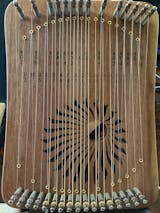The handpan is a relatively new instrument with a unique sound ranging from the soft and sweet to the powerful and explosive. At first glance, the range of available scales may seem confusing, but our comprehensive list of handpan scales will help you explore all the possibilities. We'll break down each scale and explain its unique characteristics, helping you find your perfect match.
Kurd / Annaziska (MINOR):
- Kurd
- All the notes and chords from the minor scale.
- Many harmonic possibilities with intuitive natural chord progression.
- Popular scale
- Easy to play with other handpan
- Good to play with other instruments.
- Styles : From dreamy to mystical to happy and hopeful
- Mysterious and meditative, the Kurd scale is among the most popular Hand Pan Scales ever made as it is basically a full minor scale.
- The Kurd scale is a full natural minor handpan scale, which means it has all the notes in the key of D minor. It is also sometimes referred to as Aeolian mode in western music theory. This mysterious and meditative scale is among the most popular handpan scales ever made.
- The Kurd scale can be played on a handpan by following the notes in the key of D minor (D, A, Bb, C, E, F, G, A). The layout of the notes on the drum can impact how you play them, so it's essential to familiarize yourself with the handpan's note placement.
- The Kurd scale is known for its mysterious and meditative sound. It offers a peaceful and insistent scale that can evoke a wide range of emotions, from tension and darkness to brightness and joy. This versatility makes it a popular choice for handpan players of all skill levels.
- The Kurd scale has gained popularity in part due to early viral videos by Hang Massive, Daniel Waples, and David Swarup, which showcased the captivating sound of D minor handpans. Additionally, Sam Maher's viral video of a C# Kurd, also referred to as "Annaziska," has further popularized the scale.
- C# ANNAZISKA
- The C# Annaziska scale is another very popular handpan for beginners. Exactly like the D Kurd/Aeolian in layout, but half a step lower, making it a deeper sounding handpan. This handpan is constructed to be resonant and playable with a light touch.
Celtic / Amara (MINOR):
- The Celtic Minor or Amara is based on the scale that is common in traditional Celtic music. The absence of the sixth makes this scale even more intuitive and harmonious. Suitable for every beginner. Version of the typical Irish or Scottish hexatonic Dorian/minor scale.
- Creates a suspended mood, oriented towards minor 7th chords and sounds, avoids the tension created by diminished chords.
- Styles : intuitive, easy to connect with emotionally, beautiful, touching and inspiring. Great for meditation.
Hijaz (MINOR):
- Version of an harmonic minor scale.
- Typical oriental sound.
- Suitable for percussive playing and oriental or spanish sounding melodies.
- Styles :Arabic melodies and atmospheres.
- The Hijaz scale is very common in Middle Eastern, Arabic, Flamenco and classical music. It is also quite common in many movie scores. It has often referred to this variety of scales admiringly as “Spicy”.
- These variations can be very suspenseful but also compelling, mysterious, exotic, and even quite sensual like a romantic breeze from the desert sands of timelessness. 😉
- The Hijaz scale is a Harmonic Minor. The only difference from the minor scale is a sharpened 7th note of the scale, which provides a compelling and triumphant major chord to dance around when playing progressions. Depending on which note is the foundation of a melody, it can also be considered a Phrygian Dominant scale.
- The phrygian mode is based upon the third degree of the major scale; as such, it is a minor scale. Its predominant characteristic is a flatted second degree, which gives it a “middle east” or “exotic” sound. Otherwise, it's the same as a natural minor.
- The Phrygian mode is a mode that’s in many ways similar to minor, but features a flattened second (♭ˆ2) as its distinguishing feature. If we started on E, then its ascending scale would consist of E, F, G, A, B, C, D, and E.
- Hexatonic version of a Dorian scale.
- Minor scale with a major sixth, giving it a slighter major character
- It presents a minor 3rd and a minor 7th.
- The root note is the Ding, followed by the sequence to build the root minor chord. It is a very versatile scale, as the sequence of notes can highlight a natural minor scale starting from the 5th degree of the scale or a major scale starting from the 3rd degree. The absence of the subdominant note makes this version suitable to play over several major and relative minor scales.
- Styles : mysterious, romantic, a dreamy atmosphere, smooth jazz, joyfulness.
Sabye (MAJOR):
- Diatonic version of a Lydian modal scale.
- The root note is the second lower note of the scale, while the ding is its perfect fifth, a note that finds its melodic resolution on the root of the scale.
- The Lydian mode is very similar to the major scale mode: the only difference is the augmented fourth interval, which gives it its heavenly and uplifting character.
- The peculiarity of the Sabye scale is also its last note, which is deliberately different from the root note of the Lydian scale
- Styles : intriguing suspended atmosphere.
Equinox (MINOR):
- Hexatonic minor scale.
- The root note on the Ding, followed by the minor 3rd and perfect 5th on the lower register emphasize the minor mode of this scale.
- Nice balance between major and minor moods.
- Styles : harmony, calmness and equlilibrium.
Aegean:
- The Aegean tuning is a divine scale that is said to usher in showers of rain when chanted. The associated moods are grandeur, attraction, lightness and passionate joy. According to spiritual belief, the tone combinations in this scale are said to evoke inner vision.
Mystic:
- Hexatonic natural minor scale.
- The missing tone is again the perfect fourth, the same situation of the Integral scale.
- Has the minor seventh as the last and highest sounding note of the scale, dividing the register of the handpan in two sections, a lower one with the presence of the perfect fifth and minor sixth, and a higher one where the other notes of the scale contribute to underline a melody built over the persistent sound of the root note.
- Styles : this tuning captures the magic and mystery of Arabian nights, creating soundscapes as mesmerizing as belly dancing under the stars.
- In music, the mystic chord or Prometheus chord is a six-note synthetic chord and its associated scale, or pitch collection; which loosely serves as the harmonic and melodic basis for some of the later pieces by Russian composer Alexander Scriabin. Scriabin, however, did not use the chord directly but rather derived material from its transpositions.
- When rooted in C, the mystic chord consists of the pitch classes: C, F♯, B♭, E, A, D.
- This is often interpreted as a quartal hexachord consisting of an augmented fourth, diminished fourth, augmented fourth, and two perfect fourths. The chord is related to other pitch collections, such as being a hexatonic subset of the overtone scale, also known in jazz circles as the Lydian dominant scale, lacking the perfect fifth.
- The ''Mystic'' scale is a fascinating blend of Middle Eastern melodies and mystical charm. Inspired by the traditional Hijaz scale, this tuning captures the magic and mystery of Arabian nights, creating soundscapes as mesmerizing as belly dancing under the stars.
- Mysterious Harmony of the East The sounds of this scale are like tales from a thousand and one nights, each note telling its own story, full of mystery and mystical allure. It’s a musical journey that transports the listener to a world filled with magic and unspoken depth.
Pygmy:
- Incorporating the Pygmy Scale in Handpan Music.
- The Pygmy scale is another fascinating handpan scale, characterized by its minor key and intriguing suspended atmosphere. This scale is often associated with joyfulness and shares a common root note in the Dorian scale, making it an interesting choice for those who enjoy the mystical sound of both scales.
Low Pygmy (MINOR):
- Pentatonic version of a minor scale.
- It has its root note on the Ding, and then a major 2nd, its minor 3rd, perfect 5th and minor 7th.
- A deeper variation of the "Pygmy", starting at the second in the ring around the Ding. This requires a different way of playing, which in our eyes is especially suitable for melodic playing. We recommend it to advanced players.
Asha / Ashakiran:
- "Asha" is literally translated as "hope", and "Ashakiran" as "ray of hope". She animates to cheerful, light, melancholic, hopeful melodies. While the Asha classical has only 8 tones on the upper shell, the Ashakiran is extended by a ninth tone on that one and receives at least three tones on the lower shell. Especially the second and third in the lower range and the fourth in the upper, complete the already rich Asha to a Handpan that leaves nothing to be desired.
Mixolydian (MAJOR)
- Hexatonic version of the fifth mode of the major scale.
- The root note is on the Ding, moving on towards the perfect fifth and major sixth, but omitting the minor seventh to underline the role of the root note.
- In this case, it can also be considered as a major scale without its seventh, serving the purpose of the two main major modal scales.
- Styles : happy, peacefu, perfect for music therapy.
- The YshaSavita scale is a form of hexatonic major scale without its sixth grade. It sounds as a happy and refreshing major progression, filling the player and the listeners with energy and positive vibrations. It's low center note, is expressive and mood-lifting, great for relaxing or meditation.
- The majority of the intervals are oriented towards major progressions and sounds, avoiding stable minor structures. Along with other minor scales handpans, it can be the perfect complement for advanced players who wish to complete their favorite setting only adding one other instrument.
Aeolian (MINOR)
- Complete natural minor scale.
- The presence of the low fifth on the ding along with the complete sequence of the aeolian/minor scale note is the perfect display to build all scale chords and melodic sequences.
- Full diatonic scale, with the advantage of having no other notes repeated aside from the central ding.
- Characterised by its distinctive intervals and haunting melodic contours, the Byzantine scale stands apart from traditional Western scales.
- The Byzantine Scale, also known as the Double Harmonic Scale, has a configuration that produces an exotic sound. The Byzantine scale can be thought of as a Phyrgian scale with a raised third and a raised 7th. What characterizes this scale are the whole and a half semi-step intervals between the second and third and the sixth and seventh notes.
- A scale invented by Matthieu of Shellopan, one can play Akebono, Pygmy and Equinox on this scale and hence, this scale has great potential for creating compositions and would require rigor and practice in order to master the different scales, and not be tempted to attempt to play all 3 scales at once.
Blues (MINOR)
- Experimental, yet effective handpan version of the world blues scale.
- Minor pentatonic with the addition of a chromatic note between the fourth and fifth degree, the famous blue note.
Akebono
- Pentatonic scale obtained from the traditional Japanese diatonic scale In.
- characterized by minor-second intervals between the first and the second note of the group, and a perfect fourth between the first and the last note in the group.
- In this handpan version, the ding is the root of the scale, followed by the fourth and the fifth, defining the limits of the two three-note groups and introducing its mood.
- Styles : The result is a deep and hypnotic scale, an introspective immersion in the oriental sound of this music scale.
Harmonic (MINOR):
- This scale is also a bit "spicy". The tone structure is similar to that of the "Kurd" or "Annaziska", except that here the seventh is increased and thus gives the oriental flavor. On this scale you can play wonderfully melodic as well as percussive.
MAGIC VOYAGE (MINOR)
- Pentatonic version of a minor scale.
- Similar to the Low Pygmy scale.
- It has its root note on the Ding, the minor 3rd, perfect 5th and minor 7th, and then its major 2nd.
- Styles : dreamy, effective, beautiful, deep and sustained harmonics.
PIGMY (MINOR)
- Form of Dorian pentatonic scale.
- Intervals and repeated fifths deliver a deep and full scale with no Precise central tone but brilliant and resonant, making it useful in several major and minor progressions.
- Styles : gentle, sweet, inspires introspection and meditation. Indian flavor.
PENTATONIC (MAJOR)
- Major scale without the fourth and the seventh notes.
- In one of the most classical versions, it eliminates all the half tones intervals, creating a stable and strong major movement.
- By having five tones over eight or nine notes, the result is also the natural repetition of three notes over two octaves, creating full resonance and brilliance.
- Along with a stable and consonant progression, it can be played over minor and major scales alike, representing a good choice for beginner players who wish to focus on percussion.
Japanese mode
- A feature of traditional Japanese music which at taches importance to a fine and smooth change of - pitch intonation as a way of musical expression rather than quick and wide movement.
Chinese mode
- The modern Chinese national pentatonic modes theory based on the five tones of Gong, Shang, Jue, Zhi and Yu was created by Chinese musicians who combined music theories such as absolute pitch, twelve-tone equal temperament and major/minor modes used in western music with Chinese music theory after the early twentieth century.
~~~~~~~~~~~~~~~~~~~~~~~~~~~~~~~~~~~~~~~~~~~~~~~~~~~~~~~~~~~~
Key:
D Minor
- Melancholy womanliness, the spleen and humours brood.
- The tonality of D minor is frequently linked with somber, melancholic, or even dark moods. In classical music, D minor is often used to convey a sense of tragedy or sorrow, while in rock and pop music, D minor has been used to create emotional intensity.
- Despite its reputation for being a sad or melancholic key, D minor can also convey tension, aggression, and other emotions. D minor can be used in various musical contexts, including melodies, chord progressions, and harmonies.
C Major
- C major is one of the most common keys used in music. Its key signature has no flats or sharps. Its relative minor is A minor and its parallel minor is C minor.
- Completely Pure. Its character is: innocence, simplicity, naïvety, children's talk.
G Minor
- Discontent, uneasiness, worry about a failed scheme; bad-tempered gnashing of teeth; in a word: resentment and dislike.
D Major
- D Major is a scale with an uplifting and cheerful timbre, no wonder it was called “the key of glory” in the Baroque period! It is a popular scale among beginners.
- The key of triumph, of Hallejuahs, of war-cries, of victory-rejoicing. Thus, the inviting symphonies, the marches, holiday songs and heaven-rejoicing choruses are set in this key.
- Besides, D Major will sound beautifully with a whole bunch of other drums: B Celtic Double Ding, D Celtic Minor, B Kurd, B RUS and Pan E La Sirena.
B2 Amara/Celtic
- B Amara Minor has a soothing and peaceful sound. It is a perfect scale for those who just started their musical path with RAV. It's version of the typical Irish or Scottish hexatonic Dorian/minor scale, creates a suspended mood, oriented towards minor 7th chords and sounds, avoids the tension created by diminished chords.
- It can become your best accompaniment for meditation because you don’t need to think about cords and notes but focus on your feelings.
- B Amara Minor can create a harmonious duet with B Celtic Double Ding, B RUS, B Kurd, D Major, F# In Sen and RAV Pan E La Sirena.
- Styles : intuitive, easy to connect with emotionally, beautiful, touching and inspiring. Great for meditation.
Rediscover the Beauty of B Celtic Minor 432hz;
- Our beloved B Amara Minor scale already boasts a romantic and melancholic voice that can effortlessly set the stage for a serene and peaceful atmosphere. But what if we told you that we've taken it a step further by lowering the pitch by a mere 8 Hz? This simple adjustment has given birth to a truly unique drum, one that retains the familiarity of the scale while infusing it with a whole new essence and greater resonance.
- At 432 Hz, this instrument resonates with a deeper and more grounded quality. Some even refer to it as the "planet's heartbeat," as it carries a profound spiritual and emotional significance. The distinctive pitch of B Celtic Minor 432 makes it an ideal choice for solo performances, allowing you to connect with your inner musical spirit in ways you've never experienced before.
C Minor
- C minor is a minor scale based on C, consisting of the pitches C, D, E♭, F, G, A♭, and B♭. Its key signature consists of three flats.
- Declaration of love and at the same time the lament of unhappy love. All languishing, longing, sighing of the love-sick soul lies in this key.
C# Minor
- In music notation, the key signature for C sharp minor scale flagrantly presents itself with four sharps: F#, C#, G#, and D#.
- These remarkable alterations occur in comparison to the natural minor scale, which is unaltered.
- This key signature cleverly indicates which pitches to sharpen during play. Each time you come across these notes – F, C, G, and D – your instinct should be to ascend them by a half step.
- Consequently, this tweak gives birth to the evocative tones that make the C sharp minor scale so compellingly distinctive.
- Musical compositions bearing this characteristic key invite an audience into an atmosphere soaked in deeply intriguing emotions: Penitential lamentation, intimate conversation with God, the friend and help-meet of life; sighs of disappointed friendship and love lie in its radius.
A♭ Major
- Key of the grave. Death, grave, putrefaction, judgment, eternity lie in its radius.
A♭ Minor
- Grumbler, heart squeezed until it suffocates; wailing lament, difficult struggle; in a word, the color of this key is everything struggling with difficulty.
A Major
- This key includes declarations of innocent love, satisfaction with one's state of affairs; hope of seeing one's beloved again when parting; youthful cheerfulness and trust in God.
A minor
- Pious womanliness and tenderness of character.
B♭ Major
- Cheerful love, clear conscience, hope aspiration for a better world.
B♭ minor
- A quaint creature, often dressed in the garment of night. It is somewhat surly and very seldom takes on a pleasant countenance. Mocking God and the world; discontented with itself and with everything; preparation for suicide sounds in this key.
B Major
- Strongly coloured, announcing wild passions, composed from the most glaring coulors. Anger, rage, jealousy, fury, despair and every burden of the heart lies in its sphere.
B Minor
- This is as it were the key of patience, of calm awaiting ones's fate and of submission to divine dispensation.
D♭ Major
- A leering key, degenerating into grief and rapture. It cannot laugh, but it can smile; it cannot howl, but it can at least grimace its crying.--Consequently only unusual characters and feelings can be brought out in this key.
D# Minor
- Feelings of the anxiety of the soul's deepest distress, of brooding despair, of blackest depresssion, of the most gloomy condition of the soul. Every fear, every hesitation of the shuddering heart, breathes out of horrible D# minor. If ghosts could speak, their speech would approximate this key.
E♭ Major
- The key of love, of devotion, of intimate conversation with God.
E Major - E3 B3 C#4 D#4 E4 F#4 G#4 A4 B4
- The key of E has a bright and vibrant sound due to its collection of sharps (F#, C#, G#). It evokes a sense of energy and optimism. Experiment with different scales, chords, and progressions in E major to explore its sonic characteristics further.
- Noisy shouts of joy, laughing pleasure and not yet complete, full delight lies in E Major.
- Naïve, womanly innocent declaration of love, lament without grumbling; sighs accompanied by few tears; this key speaks of the imminent hope of resolving in the pure happiness of C major.
E Aeolian
- The Aeolian mode is a musical mode or, in modern usage, a diatonic scale also called the natural minor scale.
- Sharing all of the same pitches with the natural minor scale, the Aeolian mode can be used in an incredibly wide range of musical contexts.
- Thus, it is found in much of the music on a minor key, and is sometimes modified by a harmonic or melodic minor key.
- If you play only the white notes, it is a key played on/starting and ending on A. It has a minor 3rd and a minor 7th in it. Melodic and harmonic minors will have the same but incorporate a B flat either going up or down.
F Major
- Complaisance & Calm.
F Minor
- Deep depression, funereal lament, groans of misery and longing for the grave.
F# Major
- Triumph over difficulty, free sigh of relief utered when hurdles are surmounted; echo of a soul which has fiercely struggled and finally conquered lies in all uses of this key.
F# Minor
- A gloomy key: it tugs at passion as a dog biting a dress. Resentment and discontent are its language.
G Major
- Everything rustic, idyllic and lyrical, every calm and satisfied passion, every tender gratitude for true friendship and faithful love,--in a word every gentle and peaceful emotion of the heart is correctly expressed by this key.
~~~~~~~~~~~~~~~~~~~~~~~~~~~~~~~~~~~~~~~~~~~~~~~~~~~~~~~~~~~~





